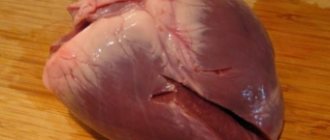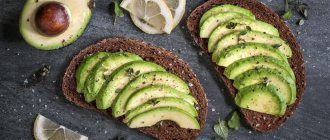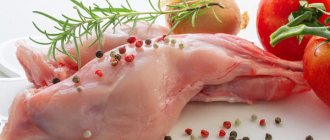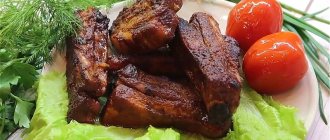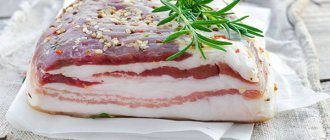With the right approach to preparing offal, their nutritional value fades into the background, giving way to taste characteristics. True, the benefits of beef heart for the human body are so great that it is difficult to ignore it. Workpieces processed using a gentle method help to establish a number of biologically important processes. They also saturate tissues with useful substances necessary to maintain health at any age.
Composition and health benefits of beef heart
The calorie content of beef heart is only 96 kcal per 100 g of product. Thanks to this, it can be safely included in the diet of people suffering from obesity and seeking to lose excess weight. The naturalness of the product allows it to be used in the menu of healthy eating enthusiasts.
Advice: The protein-rich offal is recommended to be included in the nutrition of athletes. It will prevent the breakdown of muscle tissue that results from intense training. The presence of carbohydrates and fats will contribute to the production of additional energy.
In addition to macronutrients, ash substances and unsaturated fatty acids can be distinguished in the composition of products. In many ways, the benefits and harms of beef heart are due to the presence of cholesterol. If you do not abuse the product, this substance will only bring benefits to the body.
- Animal protein is important not only for athletes, but also for children. The offal can be a suitable supplier of amino acids necessary for the formation of muscle tissue and the normal course of metabolic processes. Some of the amino acids are not even produced by the body and a person can only receive them through food.
- Beef heart is an excellent meat substitute for people on a diet. It does not contribute to excess weight gain, but at the same time it perfectly satisfies hunger.
- The ingredient is rich in magnesium, which is necessary to maintain the normal functioning of the heart and blood vessels. This substance improves the process of heart contractions.
- The offal contains 1.5 times more iron than beef, so it can be included in the diet if you have anemia or a predisposition to a pathological condition.
- Other minerals are also present in it, and in decent quantities. All of them take part in establishing mineral balance and maintaining optimal metabolic processes.
- Meat products must be included in men's menus. Due to their high zinc content, they can stimulate sexual function and have a beneficial effect on sperm quality.
- Regular use of the product helps reduce blood pressure to optimal levels and strengthen the nervous system.
- Due to the abundance of B vitamins in beef heart, the substances in the food are absorbed faster and more completely by the digestive organs.
- Meat-based dishes will be useful for people who have undergone operations, injuries, burns, and infectious diseases. The use of products during this period has a particularly good effect on the quality of blood and accelerates the restoration of its composition.
- Beef heart will also be useful in old age. It helps reduce the risk of developing atherosclerosis, heart attack, stroke, osteoporosis and other age-related manifestations of tissue wear.
The benefits of beef heart are undeniable, and with the right approach to processing the preparations, you can count on getting a tasty dish. Housewives who know how to handle the product are able to prepare real delicacies from it.
The most juicy way to cook
It has already been said that the easiest way, although not the fastest, is to boil beef heart. The calorie content per 100 grams is only 96 calories, but the taste may not be so bright in the end. But you can cook meat without compromising calorie content, but with a significant advantage in terms of juiciness and aroma. How to do it? Put out the heart. In this form, it is perfectly complemented by celery and parsley roots, as well as vegetables and any spices. It is better not to use fatty dressings.
Let's try to make goulash. To do this you will need beef heart, onion, tomato puree, vegetable oil, flour, spices and bay leaf. To prepare the meat, you need to wash it and cut it into cubes, and then put it in a pan with thick walls and fry. Then you need to add chopped onion, pour in water, add tomato and bay leaf. You can reduce the calorie content of a dish if you replace flour with starch and tomato puree with natural tomatoes. And for greater tenderness, the heart can be pre-soaked in milk for two hours.
For lovers of spicy taste, the recipe for beef heart in beer is ideal. For 300 g of meat you will need an onion, a glass of beer, the juice of half a lemon, vegetable oil, ginger and cardamom, spices to taste. Prepare a sauce based on beer, cardamom, ginger and onions, and then pour it over the stewed beef heart. Its calorie content will increase slightly due to beer, but still not detrimental to the figure.
Beef heart weighs 1.5-2 kg. The heart consists of muscles with thin fibers. In its thickest part it is wrapped in a fat “wreath”. Fat and hard tubes are usually removed in the store. When purchasing, you should make sure that there are no traces of blood in the heart chambers.
The heart has a very aromatic taste and is low in calories.
Calorie content of beef heart
The calorie content of beef heart is 96 kcal per 100 grams of product.
Beef heart composition
Beef heart is rich in vitamins E, A, PP, K.
Beef heart in cooking
Before cooking, the heart is cut lengthwise, cleaned of protruding blood vessels and films, and washed well. Beef heart consists of dense muscle fibers and requires very long heat treatment (calorizer). It must first be boiled in two waters, and both of these broths should be drained, since they are unsuitable for food.
Damage to beef heart and product features
The likelihood of harm to the body arises only with frequent and irregular consumption of the offal. If you include it in your diet no more than 2-3 times a week and limit yourself to one serving, you don’t have to worry. But neglect of established norms is fraught with the following consequences:
- Substances that have a negative effect on metabolic processes will begin to accumulate in the body. In particular, there is a risk of excess uric acid. And this is a predisposing factor to osteochondrosis, gout, radiculitis and impaired permeability of vascular walls.
- An abundance of proteins will not benefit the body. The brain will constantly receive signals that promote the release of energy. As a result, the body will begin to use up calcium reserves, which will lead to a gradual change in bone texture.
- Oversaturation of the body with protein also creates unnecessary stress on the kidneys and heart and contributes to the development of hypertension.
- The presence of cholesterol in the product can lead to exceeding the norm for this indicator in the blood. This is especially dangerous in old age. It turns out that violating the rules for eating beef heart will not reduce, but rather increase the risk of developing atherosclerosis.
Negative aspects can also be observed when consuming low quality products. In this case, the products can provoke the appearance of symptoms characteristic of food poisoning.
Selection and processing rules
Today, offal can be found in stores in a variety of forms. As for beef heart, it is most often sold chilled or frozen. The first option is much preferable, because... allows you to evaluate the quality of the product. The requirements for the workpiece should be as follows:
- A slightly sweet smell of fresh meat is a must.
- There may be no stains, dents, slime or deposits on the surface.
- The structure of the product is dense, finger pressure does not leave marks on the surface.
- The best option is the heart of a calf or young bull.
- The heart should not be washed and wrapped in film. These two points negatively affect its quality and permissible storage duration.
Benefits of beef heart
Beef heart contains a lot of protein, which makes it an excellent source of building material for the body. It is advisable for children, teenagers and athletes, especially those who strive to build muscle mass, to include it in their diet.
This product is a real storehouse of useful substances: the iron content in it is twice as high as in beef itself. It also contains a lot of copper, magnesium and zinc, which help strengthen blood vessels. This is very important for older people who often suffer from problems with the circulatory system.
Another good quality of beef heart is its high content of B vitamins, which help the body cope with stress and fatigue and are involved in regulating hormonal levels. This offal contains several times more B vitamins than beef.
Finally, beef heart is ideal for people who are watching their figure or want to lose weight: it is relatively low in calories and contains no carbohydrates. This allows those losing weight not to give up eating meat while dieting.
Important:
Beef heart is very useful for pregnant and lactating women. It allows you to replenish the lack of essential substances in the body and prevent vitamin deficiency and anemia, which young mothers often encounter while carrying a child.
Heart composition
Let's try to figure out what the beef heart hides within itself. Composition, calorie content and taste - these are the three main requests for offal. So, it has a lot of protein (about 16 g), a little fat (about 3.5 g) and very little carbohydrates (2 g). In terms of calories, 100 g of heart is approximately 5% of the daily value of an adult. Naturally, it contains water, but it also contains cholesterol and a whole list of vitamins and minerals. For greater benefit of the dish, you can combine the heart with herbs, vegetables and cereals as a side dish.
Compound
The benefits of beef heart for humans are entirely determined by its rich composition.
Calorie content of beef heart and content of proteins, fats and carbohydrates in 100 grams of product:
| Calorie content | Squirrels | Fats | Carbohydrates | Energy ratio (BZHU) |
| 112 | 17,7 | 3,9 | 0,1 | 63% | 31% | 0% |
Content of useful micro and macroelements in 100 grams of product:
| Item name | Content in mg |
| Fe (iron) | 4.8 mg |
| K (potassium) | 260 mg |
| Ca (calcium) | 7 mg |
| Mg (magnesium) | 23 mg |
| P (phosphorus) | 210 mg |
| Na (sodium) | 100 mg |
| Zn (zinc) | 2 mg |
Vitamin content per 100 grams of product:
| Name of vitamin/group of vitamins | Content in mg/mcg |
| A | 0.36 mg |
| IN 1 | 0.75 mg |
| AT 2 | 2.5 mg |
| AT 5 | 0.3 mg |
| AT 6 | 0.3 mg |
| AT 9 | 2.5 mcg |
| AT 12 | 10 mcg |
| WITH | 4 mg |
| H | 8 mcg |
Harm
If you include a reasonable amount of the product in your diet, it will not cause harm. But excessive consumption can cause kidney disease, gastrointestinal tract disease, cardiac dysfunction, and hypertension. The fact is that a large amount of protein, when digested, produces a lot of toxins, and therefore the load on all organs increases, especially on the kidneys. The body converts excess proteins into glucose and nitrogenous compounds (urea), and purine acids can be deposited in the joints (gout develops).
You need to choose a product that is freshly frozen or chilled, without stains or deposits, with a good “meaty” smell. You should not buy it in spontaneous markets where there is no veterinary control and sanitary-epidemiological services. It does not contain a high content of saturated fats and carbohydrates, carcinogens and harmful substances - it is a dietary product.
9 Health Benefits of Beef Heart
Strengthens the cardiovascular system
Improvement in the functioning of the circulatory system occurs due to the high content of zinc and magnesium: zinc helps strengthen the heart muscle and vascular walls, and magnesium is necessary in the intracellular mechanisms of regulation of heart contractions.
Promotes weight loss
Low energy value makes beef heart an ideal product for the diet of people who want to get rid of extra pounds. In addition, due to the zero glycemic index, it can be safely consumed if you have diabetes.
Regulates the balance of minerals in the body
Beef heart contains many micro and macroelements that are vital for the normal functioning of the body. Its use helps both maintain mineral balance and restore it after illnesses. Recommended for older people as a prevention of sclerosis and osteoporosis, which often arise due to a lack of minerals.
The article provides scientific facts and links to the results of many studies on the benefits of consuming beef bone marrow. For what diseases is it recommended to use it, what are the contraindications and useful recipes.
How to choose the right one
To make a beef heart dish truly tasty and healthy, you need to choose a fresh and high-quality product. You should buy it in trusted places where sanitary standards and storage conditions are observed. The heart of a young animal is best suited. It must have the following characteristics:
blood red-brown color without plaque or spots;
blood clots in the chambers;
elasticity: fabrics should immediately regain their shape when pressed.
A chilled heart is preferable to a frozen one: in this form, all its beneficial properties remain in place, but you cannot keep it in the refrigerator for more than two days. For longer storage, the product will have to be placed in the freezer.
How to prepare beef heart dishes
Before preparing a beef heart dish, it must be properly cut. This offal is distinguished by the fact that there is a lot of fat on the heart; it needs to be removed, just like blood vessels and blood clots. Therefore, first they cut off all excess, and then thoroughly wash the heart. You can cook it whole or cut into pieces. Usually the heart is boiled, baked, fried.
Before boiling the beef heart, it is soaked in water for two or three hours and then boiled. In this case, the first water is drained after 10 minutes of boiling, since the protein coagulates, and a lot of foam and gray flakes are obtained.
To get a clear broth, the water is drained again during the process - after an hour of cooking. The cooking time for beef heart depends on the age of the animal. On average, the offal is boiled for one and a half hours, but if the cow or bull was old, the cooking process can take three hours.
From boiled beef heart you can prepare hot and cold salads, pate, filling for pies and pancakes, or serve as a separate dish, after cutting it into plates. You can serve the boiled heart with greens, potatoes, rice or any other boiled cereal.
Various sauces go well with boiled beef heart - sweet, sweet and sour, tomato, creamy and others.
The raw heart can be used to make chops and goulash. The stewed heart is perfectly complemented by celery and parsley roots, vegetables, and any spices.
Gourmets prefer to eat the heart of young animals, since after cooking it is softer and has a more delicate taste. And such an offal is prepared faster and easier than the heart of an old animal.
The calorie content of beef heart is insignificant, but in order to prepare a truly dietary dish, it is important not to use fatty dressings, not to fry the heart, but only boil or bake it.
It’s good to prepare breakfasts with heart: fried spaghetti, sandwiches with boiled beef heart, stewed potatoes with fried heart and carrots. These dishes made from beef heart perfectly fill you up and give you energy for the whole day.
Athletes and people engaged in mental and physical labor will especially appreciate the benefits of beef heart as an invigorating food product.
How to cook healthy
Beef heart does not appear on the everyday menu very often, despite the fact that a huge number of dishes can be prepared with it. Before moving on to the cooking process, you need to cut off the fat layer and carefully remove large vessels and blood clots, if any - in some cases, the heart goes on sale already in a processed form. After cutting, it must be washed thoroughly.
The next stage of preparing the heart is soaking. You can simply leave it to soak in cold, lightly salted water for 2-3 hours, or cook it for 1.5-2 hours, changing the water every half hour. If the heart came from an older animal, the process may take much longer.
Raw beef heart can be immediately fried or stewed and makes excellent chops, gravy or goulash. To make the dish less caloric, bake it in the oven. Mushrooms or salad onion rings best highlight and enhance the taste of the heart.
Boiled beef heart has the same bright taste and retains its beneficial qualities much better. You can use it to prepare salads, pates, make pie filling, or serve in its pure form, after cutting it. It is most beneficial to use vegetables as a side dish: vegetable carbohydrates will balance the proteins contained in the heart and create a combination that is optimal for absorption by the digestive system.
What to cook
A variety of dishes are prepared from the heart of beef. It is boiled whole for salads and appetizers, fried, baked and stewed. There are many recipes for pates, fillings for pancakes, pies and salads. In addition, beef heart makes excellent meatballs, goulash, and fried spaghetti.
Stewed heart dishes are ideally combined with vegetables, roots, and spices. And the sauce used emphasizes the pronounced taste of the finished dish.
Since beef heart has beneficial dietary properties and a rich protein composition, it is good to make breakfasts from it: sandwiches or scrambled eggs. Dishes from the heart charge the body with energy for the whole day.
For the dish to be truly tasty and no less healthy, you need to properly prepare the heart itself.
Contraindications for use
Including beef heart in your diet can bring not only benefits, but also harm. Most often this happens when the product is incorrectly selected or stored. Abuse of it can also cause unpleasant consequences: the protein contained in the tissues is necessary for the body, but too large doses can cause kidney problems, digestive upset, elevated hemoglobin levels and hypertension. The body will process excess protein into toxic urea, which will begin to accumulate in cells.
The only serious contraindication for eating beef heart is individual intolerance. It should also be given to young children with caution so as not to provoke intestinal problems.
It is optimal to include beef heart in your diet 2-3 times a week with a side dish of vegetables. This way the body will receive all the substances it needs without harm to health.
Beef heart belongs to category 1 by-products, which are distinguished by a high content of biologically active substances, and are actively used in the diet for preparing both independent dishes and in the form of side dishes and additives to others. In nutritional value it is quite a bit inferior to meat; consists of dense muscle tissue with very fine fibers. Value, taste and quality depend on age - young is better in all respects.
For those losing weight
If you are watching your diet and your figure, then be sure to add beef heart to your diet. Its calorie content may vary depending on the spices and sauces used. During the cooking process, it is important not to overdo it with the duration of heat treatment, since beef contains enough vitamins A, B, E, K. It also contains a lot of iron, magnesium, phosphorus, calcium, zinc and potassium. From everything we can conclude that the offal helps with anemia, heart disease, and nervous ailments. In addition, this product improves metabolism. Boiled beef heart is considered the most dietary. Its calorie content remains at a minimum level of 92-96 calories per 100 grams. With such an energy value, you can allow the meat to be flavored with sweet and sour or even mayonnaise sauce, albeit based on low-fat mayonnaise or sour cream.
The calorie content of boiled beef heart allows you to eat it even in the evening without harming your figure. From time to time, meat should be given to children and adolescents, and included in the menu for patients undergoing long-term treatment or adaptation after surgery. Fat must be removed before cooking and the product must be soaked before boiling. By the way, when boiling, the first water must be drained, as the protein coagulates and foam with gray flakes appears. In order for the broth to be clear, the water must be drained twice. The heart will cook for about an hour and a half, but if the cow was old, the time will double. You shouldn't eat the meat right away; it may seem a little dry. Cut into portions and prepare the dressing if you don’t want to bother with the salad or pie. For dressing, just lemon juice, mustard and garlic are enough. When biting it, the meat becomes juicy and aromatic.
